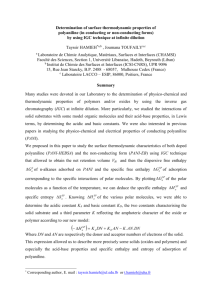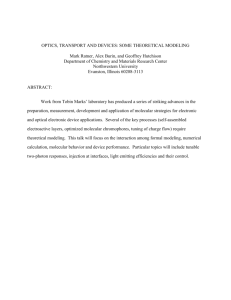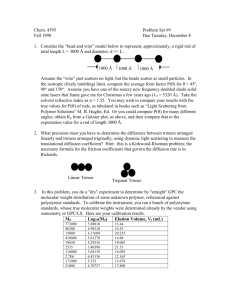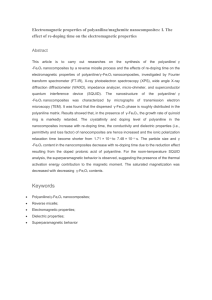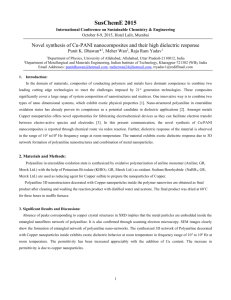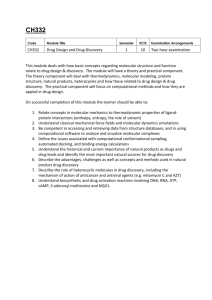Absolute Molecular Weight of Polyaniline
advertisement
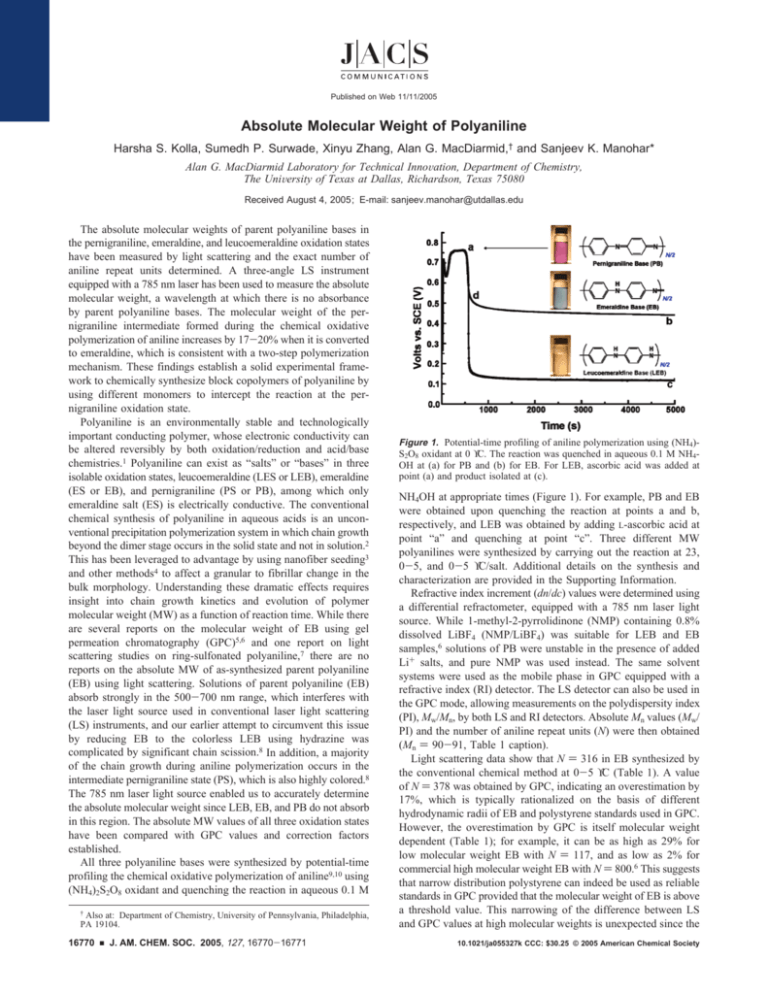
Published on Web 11/11/2005
Absolute Molecular Weight of Polyaniline
Harsha S. Kolla, Sumedh P. Surwade, Xinyu Zhang, Alan G. MacDiarmid,† and Sanjeev K. Manohar*
Alan G. MacDiarmid Laboratory for Technical InnoVation, Department of Chemistry,
The UniVersity of Texas at Dallas, Richardson, Texas 75080
Received August 4, 2005; E-mail: sanjeev.manohar@utdallas.edu
The absolute molecular weights of parent polyaniline bases in
the pernigraniline, emeraldine, and leucoemeraldine oxidation states
have been measured by light scattering and the exact number of
aniline repeat units determined. A three-angle LS instrument
equipped with a 785 nm laser has been used to measure the absolute
molecular weight, a wavelength at which there is no absorbance
by parent polyaniline bases. The molecular weight of the pernigraniline intermediate formed during the chemical oxidative
polymerization of aniline increases by 17-20% when it is converted
to emeraldine, which is consistent with a two-step polymerization
mechanism. These findings establish a solid experimental framework to chemically synthesize block copolymers of polyaniline by
using different monomers to intercept the reaction at the pernigraniline oxidation state.
Polyaniline is an environmentally stable and technologically
important conducting polymer, whose electronic conductivity can
be altered reversibly by both oxidation/reduction and acid/base
chemistries.1 Polyaniline can exist as “salts” or “bases” in three
isolable oxidation states, leucoemeraldine (LES or LEB), emeraldine
(ES or EB), and pernigraniline (PS or PB), among which only
emeraldine salt (ES) is electrically conductive. The conventional
chemical synthesis of polyaniline in aqueous acids is an unconventional precipitation polymerization system in which chain growth
beyond the dimer stage occurs in the solid state and not in solution.2
This has been leveraged to advantage by using nanofiber seeding3
and other methods4 to affect a granular to fibrillar change in the
bulk morphology. Understanding these dramatic effects requires
insight into chain growth kinetics and evolution of polymer
molecular weight (MW) as a function of reaction time. While there
are several reports on the molecular weight of EB using gel
permeation chromatography (GPC)5,6 and one report on light
scattering studies on ring-sulfonated polyaniline,7 there are no
reports on the absolute MW of as-synthesized parent polyaniline
(EB) using light scattering. Solutions of parent polyaniline (EB)
absorb strongly in the 500-700 nm range, which interferes with
the laser light source used in conventional laser light scattering
(LS) instruments, and our earlier attempt to circumvent this issue
by reducing EB to the colorless LEB using hydrazine was
complicated by significant chain scission.8 In addition, a majority
of the chain growth during aniline polymerization occurs in the
intermediate pernigraniline state (PS), which is also highly colored.8
The 785 nm laser light source enabled us to accurately determine
the absolute molecular weight since LEB, EB, and PB do not absorb
in this region. The absolute MW values of all three oxidation states
have been compared with GPC values and correction factors
established.
All three polyaniline bases were synthesized by potential-time
profiling the chemical oxidative polymerization of aniline9,10 using
(NH4)2S2O8 oxidant and quenching the reaction in aqueous 0.1 M
†
Also at: Department of Chemistry, University of Pennsylvania, Philadelphia,
PA 19104.
16770
9
J. AM. CHEM. SOC. 2005, 127, 16770-16771
Figure 1. Potential-time profiling of aniline polymerization using (NH4)S2O8 oxidant at 0 °C. The reaction was quenched in aqueous 0.1 M NH4OH at (a) for PB and (b) for EB. For LEB, ascorbic acid was added at
point (a) and product isolated at (c).
NH4OH at appropriate times (Figure 1). For example, PB and EB
were obtained upon quenching the reaction at points a and b,
respectively, and LEB was obtained by adding L-ascorbic acid at
point “a” and quenching at point “c”. Three different MW
polyanilines were synthesized by carrying out the reaction at 23,
0-5, and 0-5 °C/salt. Additional details on the synthesis and
characterization are provided in the Supporting Information.
Refractive index increment (dn/dc) values were determined using
a differential refractometer, equipped with a 785 nm laser light
source. While 1-methyl-2-pyrrolidinone (NMP) containing 0.8%
dissolved LiBF4 (NMP/LiBF4) was suitable for LEB and EB
samples,6 solutions of PB were unstable in the presence of added
Li+ salts, and pure NMP was used instead. The same solvent
systems were used as the mobile phase in GPC equipped with a
refractive index (RI) detector. The LS detector can also be used in
the GPC mode, allowing measurements on the polydispersity index
(PI), Mw/Mn, by both LS and RI detectors. Absolute Mn values (Mw/
PI) and the number of aniline repeat units (N) were then obtained
(Mn ) 90-91, Table 1 caption).
Light scattering data show that N ) 316 in EB synthesized by
the conventional chemical method at 0-5 °C (Table 1). A value
of N ) 378 was obtained by GPC, indicating an overestimation by
17%, which is typically rationalized on the basis of different
hydrodynamic radii of EB and polystyrene standards used in GPC.
However, the overestimation by GPC is itself molecular weight
dependent (Table 1); for example, it can be as high as 29% for
low molecular weight EB with N ) 117, and as low as 2% for
commercial high molecular weight EB with N ) 800.6 This suggests
that narrow distribution polystyrene can indeed be used as reliable
standards in GPC provided that the molecular weight of EB is above
a threshold value. This narrowing of the difference between LS
and GPC values at high molecular weights is unexpected since the
10.1021/ja055327k CCC: $30.25 © 2005 American Chemical Society
COMMUNICATIONS
Table 1. Number of Aniline Repeat Units (N) and Weight Average Molecular Weight (Mw) for Polyaniline Measured by Light Scattering (LS)
and Gel Permeation Chromatography (GPC)
0−5 °C/salt
dn/dca
pernigraniline
(PB)e
0.50e
emeraldine (EB)f
0.41f
leucoemeraldine (LEB)f
0.29f
0−5 °C
Nb
23 °C
Nb
Mw
LS
GPC (PI)c
LS/GPC
(diff)d
Mw
LS
GPC (PI)c
LS/GPC
(diff)d
Mw
LS
GPC (PI)c
Nb
LS/GPC
(diff)d
74900
84135 (2.3)
95800
104707 (2.4)
84550
93085 (2.3)
362/406
(10.9%)
441/482
(8.6%)
404/445
(9.3%)
52470
64092 (2.2)
68580
82296 (2.4)
55950
67257 (2.3)
265/323
(17.9%)
316/378
(16.6%)
267/321
(16.9%)
24160
34365 (2.3)
30102
42206 (2.3)
26100
36279 (2.2)
117/166
(29.6%)
145/203
(28.6%)
130/181
(28.2%)
a Refractive index increment. b Number of aniline repeat units [(M /PI)/wt of repeat unit] (PB ) 90; EB ) 90.5; LEB ) 91). c Polydispersity index
w
(Mw/Mn). d Percent difference between NGPC - NLS. e NMP solvent. f NMP/LiBF4 solvent. MW values in Daltons.
conformation in solution of a polar, H-bonding polymer such as
EB in NMP is expected to be significantly different from nonpolar
polystyrene standards. A similar conformational leveling at high
molecular weights is observed in the narrowing of LS and GPC
values in LEB, and also in PB, which cannot form H-bonds with
NMP (Table 1).
Interestingly, the percent difference between LS and GPC falls
in clusters, 9-11, 17-18, and 28-30%, which are differentiated
by molecular weight and not oxidation state; for example, for a
given molecular weight range, LEB, EB, and PB all fall within a
given cluster. This suggests that the conformation in solution of
LEB, EB, and PB, while expectedly different from PS standards,
differs from it by similar amounts. The reasons for this are unclear,
for one might have expected PB to be more rod-like versus PS
standards compared to LEB or EB.
Light scattering data show N ) 265 for PB isolated at the edge
plateau of the potential-time profile (Figure 1, point a) for the
synthesis carried out at 0 °C. An additional 51 aniline units are
added during the conversion of pernigraniline to emeraldine (EB,
N ) 316), an increase of ∼19% that is consistent with our proposed
two-step mechanism of aniline polymerization.9 In this mechanism,
84% of ES originates from the pernigraniline intermediate when it
is reduced to emeraldine (ESp) by excess aniline. The remaining
16% comes from the freshly oxidized aniline that can either
polymerize independently to emeraldine (ESa) to yield a physical
mixture of [ESp]84% and [ESa]16% or couple with existing ESp chains
to yield a “block copolymer” of {[ESp]84%-[ESa]16%}. The increase
in MW observed in this study also validates this mechanism and
our earlier study on electrochemically synthesized block copolymers
of polyaniline and poly(2-methylaniline), where confirmatory
evidence was lacking since there was no access to absolute
molecular weight values.11 Polymer molecular weight was also
continuously monitored with reaction time by quenching aliquots
at appropriate points along the potential-time profile, and again, a
∼19% increase in molecular weight was observed during the
conversion of PB to EB. Importantly, we found that it takes time
for the freshly oxidized aniline units to couple with existing
polyaniline chains; that is, the polyaniline isolated immediately upon
fall of potential at 0.52 V (Figure 1, point d) still had the same
number of aniline repeat units as that isolated at 0.75 V (Figure 1,
point a). It should therefore be possible to synthesize a variety of
block copolymers by adding a different monomer at the edge of
the plateau region. Indeed, when excess 2-methylaniline is added
at the edge of the potential-time plateau (0.75 V), after first
converting all the aniline to pernigraniline (using an aniline/S2O82ratio of 1:1.5), a 11-13% increase in MW is observed. Since the
product was washed with dichloromethane to remove any residual
poly(2-methylaniline) homopolymer, the observed MW increase is
consistent with the coupling of 2-methylaniline units to existing
parent polyaniline chains. This coupling must have occurred at the
chain ends, similar to the parent polyaniline system. The cyclic
voltammogram in aqueous 1.0 M HCl shows redox peaks that have
features common to both polyaniline and poly-2-methylaniline.
Elemental analysis (carbon/nitrogen ratio) is also consistent with
the formation of a (polyaniline)89-(poly-2-methylaniline)11 block
copolymer (see Supporting Information for details).
In summary, this study describes, for the first time, (i) the
absolute molecular weight of parent polyaniline in all three isolable
oxidation states, synthesized at three different temperatures, (ii) the
molecular weight dependent correction factors for GPC measurements, (iii) evidence consistent with a two-step aniline polymerization mechanism that opens a simple and rapid chemical route to
synthesize block copolymers of polyaniline.
Acknowledgment. We gratefully acknowledge helpful discussions with Dr. Michelle Chen (Wyatt Technology Corp.) and
financial support from The University of Texas at Dallas.
Supporting Information Available: Synthesis, UV/vis, FT/IR, dn/
dc, light scattering, and GPC. This material is available free of charge
via the Internet at http://pubs.acs.org.
References
(1) MacDiarmid, A. G. Angew. Chem., Int. Ed. 2001, 40, 2581.
(2) (a) Huang, W. S.; MacDiarmid, A. G.; Epstein, A. J. J. Chem. Soc., Chem.
Commun. 1987, 1784. (b) Zhang, X.; Manohar, S. K. Chem. Commun.
2004, 20, 2360. (c) Wei, Y.; Sun, Y.; Jang, G.; Tang, X. J. Polym. Sci.
C: Polym. Lett. 1990, 28, 81.
(3) Zhang, X.; Goux, W. J.; Manohar, S. K. J. Am. Chem. Soc. 2004, 126,
4502.
(4) (a) Huang, J.; Kaner, R. B. J. Am. Chem. Soc. 2004, 126, 851. (b) Huang,
J.; Kaner, R. B. Angew. Chem., Int. Ed. 2004, 43, 5817. (c) Li, W.; Wang,
H.-L. J. Am. Chem. Soc. 2004, 126, 2278. (d) Wan, M. Encycl. Nanosci.
Nanotechnol. 2004, 2, 153. (e) Wang, Y.; Liu, Z.; Han, B.; Sun, Z.; Huang,
Y.; Yang, G. Langmuir 2005, 21, 833. (f) Zhang, X.; Roch, C.-Y.-K.;
Jose, A.; Manohar, S. K. Synth. Met. 2004, 145, 23.
(5) (a) Huang, J.; Moore, J. A.; Acquaye, J. H.; Kaner, R. B. Macromolecules
2005, 38, 317. (b) Smela, E.; Mattes, B. R. Synth. Met. 2005, 151, 43. (c)
Yang, D.; Adams, P. N.; Mattes, B. R. Synth. Met. 2001, 119, 301.
(6) Yang, D.; Adams, P. N.; Goering, R.; Mattes, B. R. Synth. Met. 2003,
135-136, 293. Samples purchased from Santa Fe Science and Technology
Inc. [Mw ) 196200 (LS), 217643 (GPC), PI: 2.7].
(7) Hsu, C. H.; Peacock, P. M.; Flippen, R. B. Synth. Met. 1993, 60, 223.
(8) Hsu, C. H.; Peacock, P. M.; Flippen, R. B.; Manohar, S. K.; MacDiarmid,
A. G. Synth. Met. 1993, 60, 233.
(9) Manohar, S. K.; MacDiarmid, A. G.; Epstein, A. J. Synth. Met. 1991, 41,
711.
(10) Wei, Y.; Hsueh, K. F.; Jang, G. W. Polymer 1994, 35, 3572.
(11) Mattoso, L. H. C.; Oliveira, O. N., Jr.; Faira, R. M.; Manohar, S. K.;
Epstein, A. J.; MacDiarmid, A. G. Polym. Int. 1994, 35, 89.
JA055327K
J. AM. CHEM. SOC.
9
VOL. 127, NO. 48, 2005 16771
